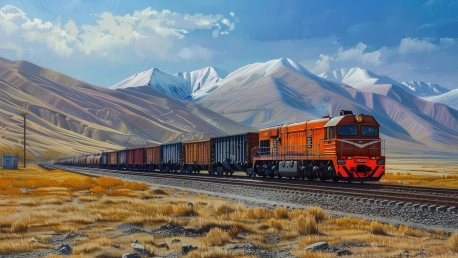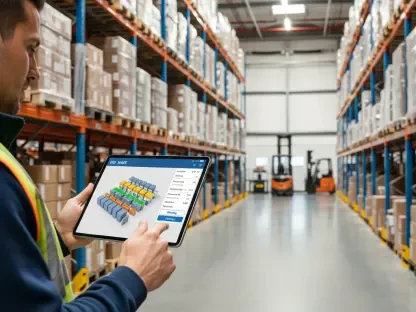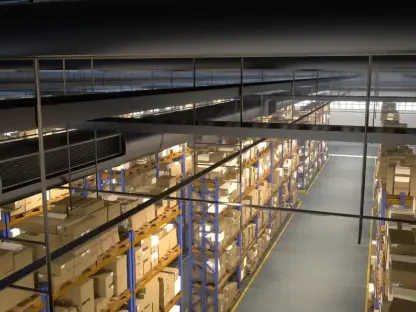Linking Europe and Asia, forging a modern Silk Road, and potentially redefining global logistics, the Trans-Caspian International Transport Route, known as the Middle Corridor, is a beacon of potential for Eurasian trade. A recent interview with Clemens Först, CEO of ÖBB Rail Cargo Group, sheds light on the corridor’s increasing strategic significance and the pivotal role it may play in reshaping international commerce.
Understanding the Middle Corridor
The Geopolitical Pivot to the Middle Corridor
The Middle Corridor has crystallized as a vital lifeline connecting East and West in a world of shifting geopolitical landscapes. Clemens Först spoke at length about the urgent need for reliable alternative routes that has arisen due to recent global tensions. The Middle Corridor promises to provide such an alternative, circumventing traditional maritime pathways that are increasingly viewed as vulnerable to political and environmental uncertainties. ÖBB, with its eye on future-proofing trade routes, sees this land bridge as an integral component of a reconfigured global transport architecture.
Strategic Implications for Austria and Central Europe
Austria envisions itself at the heart of a thriving trade nexus, where the Middle Corridor plays a pivotal role. This ambition transcends national borders—ÖBB’s strategy positions the nation as a central logistics hub in Europe. By reinforcing and capitalizing on the trade connection with Asian markets through this route, ÖBB is championing a strategic initiative that could have vast economic repercussions for Central Europe, unlocking new potential in East-West commerce.
Collaborations and Advancements
Forging Partnerships Across Borders
Central to the success of the Middle Corridor is ÖBB’s established ties with state railway companies across Central Asia, including Kazakhstan, Azerbaijan, and Georgia. These partnerships, particularly in rail freight transport, are the bricks and mortar of this intercontinental venture. ÖBB has been instrumental in providing a seamless end-to-end transport chain from Europe to Asia, facilitating trade, and unlocking unprecedented economic opportunities for the regions it touches.
Progress Achieved and Challenges Ahead
While significant strides have been made in developing efficient logistics channels along the Middle Corridor, Först is candid about the challenges that lie ahead. Indeed, the construction of a cost-effective and reliable transport artery requires sustained effort. The initiatives undertaken with regional partners reflect the collaborative nature of this venture and the belief in shared potential. Yet, as with any large-scale project, obstacles must be navigated, especially when building a conduit that aims to stand the test of time and fluctuating geopolitical climates.
Sustainability and Continuous Development
Navigating Geopolitical Challenges
For the Middle Corridor to flourish, Kazakhstan and its neighbors must capitalize on the opportunities presented by the current geopolitical climate. Strengthening this route means bolstering its resilience against international volatility. The current surge in demand is an advantageous springboard, but to maintain viability, nations involved will need to ensure continuous operation and adaptability in the face of global trade dynamics.
Advancing Operational Capabilities
The future of the Middle Corridor rests upon the robust shoulders of ongoing development—its capacity to meet trade demands with speed, cost-effectiveness, and reliability. Först highlights the necessity for evolution, focusing on achieving a balance that fortifies trade relations between Europe and Asia while also mitigating the risk of geopolitical disruptions. Continuous improvement and optimization are crucial to living up to the corridor’s prospective role in the trade network.
Economic Implications and Potential Growth
Unlocking Economic Opportunities
A fully operational Middle Corridor could open a treasure trove of economic benefits. It is envisioned as a catalyst for expanding trade and commerce, offering a speedier, more efficient, and tech-forward alternative that dovetails with the ecological and economic imperatives of our time. ÖBB and its partners are committed to transforming this potential into a tangible reality, unlocking prosperity for a wealth of regions across continents.
The Vision for a Permanent Eurasian Link
How can the Middle Corridor transcend its current narrative and become a permanent fixture in global logistics? ÖBB’s strategic consensus suggests that it’s not just ambition but also feasible planning driving the corridor’s development. Stakeholders are rallying around the vision of an enduring trade link, confident in its promise as a desirable land route juxtaposed to the slower maritime paths.
The Path Forward for Eurasian Connectivity
Next Steps in Route Development
To bring the Middle Corridor’s full capabilities to light, specific strategic actions will be essential. These include policy alignment, infrastructure investment, and standardization of logistics processes, paving the way for a robust and efficient artery of cross-continental trade. ÖBB and its partners recognize that realizing the Middle Corridor’s potential will shape the future narrative of their regions and beyond.
Building Resilient Trade Structures
Bridging the vast expanse between Europe and Asia, the Trans-Caspian International Transport Route, also known as the Middle Corridor, stands as a testament to modern geopolitical innovation and economic progress. This pathway aims to revive the legendary Silk Road in a contemporary context, offering a route that may transform the dynamics of global trade. In an insightful discussion with Clemens Först, the CEO of ÖBB Rail Cargo Group, the burgeoning significance of this route comes into clearer focus. Först highlights the strategic importance that the Middle Corridor holds, with the potential to serve as a catalyst in the renewal of logistical routes across Eurasia.As the artery of commerce between two continents, its development symbolizes the gradual shift in trade routes, echoing the ancient networks of exchange that once revolutionized the way goods were traded. The modern Silk Road envisaged by the Middle Corridor promises an era where distances shrink and the exchange of goods accelerates, thus possibly redefining the very fabric of international trade. The CEO’s insights affirm that the Middle Corridor isn’t just a physical thoroughfare but a critical component in the drive towards a more interconnected and efficiently serviced trade landscape. Through this, the Middle Corridor is positioned to become a linchpin in the evolution of trade, bearing the potential to profoundly influence the global market.









